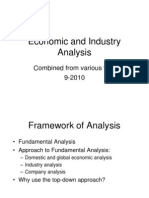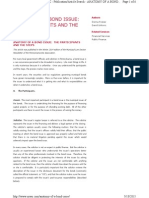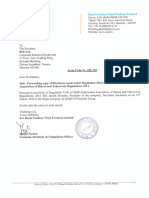Playing The REITs Game
Playing The REITs Game
Uploaded by
onlylf28311Copyright:
Available Formats
Playing The REITs Game
Playing The REITs Game
Uploaded by
onlylf28311Original Description:
Original Title
Copyright
Available Formats
Share this document
Did you find this document useful?
Is this content inappropriate?
Copyright:
Available Formats
Playing The REITs Game
Playing The REITs Game
Uploaded by
onlylf28311Copyright:
Available Formats
Playing the REITs Game
Author ! : Dominic Whiting ISBN ! : 978-0-470-82204-3
Summary
Attractiveness of REITs Diversication Low correlation between stocks and bonds. Securities investments in the same property type in different countries have a lower correlation than investments in different property type. Liquidity Traded like stock Singapore has one of the cheapest prime ofce rentals compared to other major cities in the world. Singapore has the potential to be the hub of SEA REITs with REITs market in SEA still in its infancy. However, this posses problems such as currency exchange issues, other regulations such as different tax and reporting standards in a cross-border REITs. Dangers of REITs Susceptible to nancial engineering. e.g. delaying issuance of new trust units, so that existing shareholders might have a larger share of newly added rental for the interim period. This is done in hope that by the time the issuance of the new units, rental prices will have risen and existing shareholders will not feel the drop in income from the trust. Dubious fees and hidden debts. Yield income is just a part of REITs not the whole part. e.g. REITs managers might make bad acquisition to increase their fees. CapitaLand asset light model Able to sell at a relatively higher price of building to its own trust as investors are more likely to pay higher for a more liquid property asset. CapitaLand still keeps a stake(30%) and control of the building! So now it earns 2 sources of fees 1. Fees for managing the trusts. 2. Fees from managing the building. This model is proven in the Singapore and China Retail Mall trusts. CapitaLand will be thus incubating building for their REITs trust, which will take over once the building is up. Singapore REITs Rules Able to invest in property abroad Gearing ratio of up to 60% Paying at least 90% of distributable income back to investors. Cannot invest in property development, either own their own or partially
4 part property cycle. 1. 2. 3. 4. Growth Deterioration Decline Recovery
Factors to take note: Geographical location of properties Over-reliance on a few major tenants for occupancy Over-reliance on a few properties for income Renewal of lease should be done in a staggered manner Building quality Management Fees If dividend yield is greater than property yield, there might be some form of nancial engineering involved. Net Asset Value (NAV) / Book Value 1. Replacement Cost Approach (includes construction cost, land price, labour, etc...) -- difcult to access 2. Benchmark to similar sales of similar buildings. -- more commonly employed 3. Capitalization Rate - Net operating income as a % of building value Discounted Cash Flow (DCF) - Basically, forecasting future cash ow and taking into account the discount rate, or cost of capital (equity+debt), to get the current desired cash ow Discounted Dividend Model (DDM) - Same as DCF except the discount rate is the cost of equity, which can be obtained based on bond rates and the equity beta of the stock. Financing - From Bank Loan or Commercial Mortgage Backed Securities (CMBS) and at what rate and leverage. Ination - Annual Dividend Growth Per Share has to be > than CPI
Learning Points
REITs market is very favorable in Singapore with tax free capital gains and a transparent system. Companies that have an edge are Ascendas and CaptialLand, which are venturing into cross border acquisition in India and China recently. The strong backing of the REITs by their own developers also means that an existing market would be present when a building is completed. Financial Engineering could be present in REITs reports so investors have to be careful. REITs proved to be relatively attractive because of its resilience to downturns and high liquidity. It is worth considering when balancing and diversifying your portfolio.
You might also like
- Final SIP Project PDFDocument63 pagesFinal SIP Project PDFSunil Thakur100% (5)
- IAM Constitution 2012Document202 pagesIAM Constitution 2012LaborUnionNews.comNo ratings yet
- Defeasance and Your Deal PDFDocument8 pagesDefeasance and Your Deal PDFcleveland123100% (2)
- Unit 10 - Investment Company ProductsDocument4 pagesUnit 10 - Investment Company ProductsdgnyNo ratings yet
- Debt SecuritizationDocument19 pagesDebt SecuritizationJames RossNo ratings yet
- DebtCapitalMarkets TheBasics AsiaEditionDocument28 pagesDebtCapitalMarkets TheBasics AsiaEditionVivek AgNo ratings yet
- IDSS MplusDocument4 pagesIDSS MplusKen ChewNo ratings yet
- Measuring Business Interruption Losses and Other Commercial Damages: An Economic ApproachFrom EverandMeasuring Business Interruption Losses and Other Commercial Damages: An Economic ApproachNo ratings yet
- President and CEO of Boston Beer Company Steps DownDocument28 pagesPresident and CEO of Boston Beer Company Steps DownBoston 25 DeskNo ratings yet
- WbsDocument32 pagesWbsdeven_cNo ratings yet
- CH 23Document25 pagesCH 23YolomanNo ratings yet
- How Hedge Funds Are StructuredDocument15 pagesHow Hedge Funds Are StructuredEmmanuel DeiparineNo ratings yet
- Ceo Letter To Shareholders 2020Document66 pagesCeo Letter To Shareholders 2020Zerohedge100% (1)
- 6 Capital Market Intermediaries and Their RegulationDocument8 pages6 Capital Market Intermediaries and Their RegulationTushar PatilNo ratings yet
- Lehman Brothers and LIBOR ScandalDocument16 pagesLehman Brothers and LIBOR Scandalkartikaybansal8825No ratings yet
- 52955515Document133 pages52955515mohamedNo ratings yet
- Capital Raising Regulation D SEC Vladimir IvanovDocument11 pagesCapital Raising Regulation D SEC Vladimir IvanovCrowdfundInsiderNo ratings yet
- Types of CDOsDocument9 pagesTypes of CDOsKeval ShahNo ratings yet
- Key Terms of The Investment AgreementDocument7 pagesKey Terms of The Investment AgreementYsmari Maria TejadaNo ratings yet
- Alternative Offshore StructureDocument18 pagesAlternative Offshore StructureAndre Sylvestre100% (1)
- KKR KioDocument2 pagesKKR KioHungreo411No ratings yet
- Types of Deposits Offered by BanksDocument6 pagesTypes of Deposits Offered by Banksfarhana nasreenNo ratings yet
- Bonds: What Are They and What Do They Do?Document12 pagesBonds: What Are They and What Do They Do?Shapthami ManokarNo ratings yet
- (John Tuld) : Professional ExperienceDocument2 pages(John Tuld) : Professional Experienceدولت ابد مدت Devlet-i Aliyye-i OsmâniyyeNo ratings yet
- Cash Flow StatementDocument2 pagesCash Flow StatementEvy Nonita AnggusNo ratings yet
- Maples and Calder: Cayman Islands Attorneys-at-LawDocument4 pagesMaples and Calder: Cayman Islands Attorneys-at-Lawed_nycNo ratings yet
- What Is The Difference Between P & L Ac and Income & Expenditure Statement?Document22 pagesWhat Is The Difference Between P & L Ac and Income & Expenditure Statement?pranjali shindeNo ratings yet
- Convertible DebtDocument10 pagesConvertible DebtrajaNo ratings yet
- PIMCO TRF PropsectusDocument23 pagesPIMCO TRF PropsectusZerohedgeNo ratings yet
- CS US Multi-Industrial Analyst Presentation - July 2014 - Part 1 End Market SlidesDocument220 pagesCS US Multi-Industrial Analyst Presentation - July 2014 - Part 1 End Market SlidesVictor CheungNo ratings yet
- Guide To Par Syndicated LoansDocument10 pagesGuide To Par Syndicated LoansBagus Deddy AndriNo ratings yet
- Startup Guide Investor Term Sheet 1682738553Document12 pagesStartup Guide Investor Term Sheet 1682738553Priyanka KhemaniNo ratings yet
- 2.3 Fra and Swap ExercisesDocument5 pages2.3 Fra and Swap ExercisesrandomcuriNo ratings yet
- Special Report & Survey:: CurrencyDocument3 pagesSpecial Report & Survey:: CurrencyLinda FreemanNo ratings yet
- Dell Inc LBO Proxy Filing. March 29. 2013Document274 pagesDell Inc LBO Proxy Filing. March 29. 2013Arik HesseldahlNo ratings yet
- Tim and Jane GoldbergDocument15 pagesTim and Jane GoldbergFinancial SenseNo ratings yet
- Collective Investement SchemesDocument28 pagesCollective Investement SchemesEmeka Nkem100% (1)
- The Direct Investment & Deal Flow Summit: June 27th - The Edison Ballroom - NYCDocument5 pagesThe Direct Investment & Deal Flow Summit: June 27th - The Edison Ballroom - NYCgneymanNo ratings yet
- RepoDocument7 pagesRepoMonil VisariyaNo ratings yet
- Basic Principles of Loan Documentation PDFDocument21 pagesBasic Principles of Loan Documentation PDFBilly LeeNo ratings yet
- Credit Application FormDocument2 pagesCredit Application Formrubiksolver100% (1)
- Credit Markets1Document45 pagesCredit Markets1David Raju GollapudiNo ratings yet
- Volans 2007-1 CDO Term SheetDocument4 pagesVolans 2007-1 CDO Term Sheetthe_akinitiNo ratings yet
- What Determins Intrest RateDocument4 pagesWhat Determins Intrest RateAbdullah MalikNo ratings yet
- The Benefits of Good Loan Structuring: Cameron McraeDocument3 pagesThe Benefits of Good Loan Structuring: Cameron McraeRoman AhmadNo ratings yet
- Partners Group - FoF BenefitsDocument8 pagesPartners Group - FoF BenefitsJose M Terrés-NícoliNo ratings yet
- Economic and Industry Analysis Co Combined 9-2010Document62 pagesEconomic and Industry Analysis Co Combined 9-2010Rohit BansalNo ratings yet
- Private Equity Fund FormationDocument31 pagesPrivate Equity Fund Formationalgreen11795No ratings yet
- Can P2P Lending Reinvent BankingDocument7 pagesCan P2P Lending Reinvent BankingGlenPalmerNo ratings yet
- 11 15 16 Asset AllocationDocument60 pages11 15 16 Asset AllocationZerohedge100% (1)
- IB Internship Cover LetterDocument1 pageIB Internship Cover LetterAnonymous 3v1z9lNo ratings yet
- Model Intercreditor - A B Loans and Swap 116Document68 pagesModel Intercreditor - A B Loans and Swap 116Jim LeighNo ratings yet
- OBURE Understanding How Reits Market WorksDocument3 pagesOBURE Understanding How Reits Market WorksJohn evansNo ratings yet
- Anatomy of A Bond Issue: The Participants and The StepsDocument6 pagesAnatomy of A Bond Issue: The Participants and The Stepsshobu_iuj100% (1)
- Basics of Mutual FundsDocument14 pagesBasics of Mutual FundsrajviNo ratings yet
- International BankingDocument25 pagesInternational Bankingvikas nabikNo ratings yet
- UBS Private Market 2023Document28 pagesUBS Private Market 2023Sumanth GururajNo ratings yet
- Empirical Note on Debt Structure and Financial Performance in Ghana: Financial Institutions' PerspectiveFrom EverandEmpirical Note on Debt Structure and Financial Performance in Ghana: Financial Institutions' PerspectiveNo ratings yet
- LboDocument31 pagesLboAitorzinho Pepin100% (2)
- 60-40 SolutionDocument3 pages60-40 SolutionswarkamalNo ratings yet
- Strategic Financial Management: Complete The Crossword Puzzle BelowDocument2 pagesStrategic Financial Management: Complete The Crossword Puzzle BelowTarunvir KukrejaNo ratings yet
- HDFC - LIC Right MARKETING STRATEGIESDocument56 pagesHDFC - LIC Right MARKETING STRATEGIESMANISHA GAUTAMNo ratings yet
- Demat Project ReportDocument91 pagesDemat Project ReportVeronica VaghelaNo ratings yet
- SBI Contra Fund FactsheetDocument1 pageSBI Contra Fund FactsheetAkshad KhedkarNo ratings yet
- Pharmaceutical AccountingDocument4 pagesPharmaceutical AccountingKimberly AnnNo ratings yet
- Screen Based TradingDocument3 pagesScreen Based TradingexamonclickNo ratings yet
- ACC311 Quiz FileDocument4 pagesACC311 Quiz FilealijaleesNo ratings yet
- Hurdle Rates PresentationDocument14 pagesHurdle Rates PresentationRohit GargNo ratings yet
- Course Outline Financial Management-2018-19Document4 pagesCourse Outline Financial Management-2018-19Jayesh MahajanNo ratings yet
- Garcia Vs LlamasDocument2 pagesGarcia Vs LlamasKling King100% (2)
- Soal Se Akm 2 PDFDocument3 pagesSoal Se Akm 2 PDFrakhaNo ratings yet
- Fixed-Assets Tutorials PDFDocument6 pagesFixed-Assets Tutorials PDFSarvjeet BhayanaNo ratings yet
- Section 393 in The Companies Act, 1956Document1 pageSection 393 in The Companies Act, 1956Sanjay Ram DiwakarNo ratings yet
- Assignment On Non Performing Assets in Banking IndustryDocument16 pagesAssignment On Non Performing Assets in Banking IndustryKawalpreet Singh MakkarNo ratings yet
- Oppression Remedy (NOTES)Document7 pagesOppression Remedy (NOTES)adibah taherahNo ratings yet
- Himalaya Food - 2 PDFDocument2 pagesHimalaya Food - 2 PDFManish GoyalNo ratings yet
- PGDT ProjectDocument83 pagesPGDT ProjectAshutosh GoyalNo ratings yet
- SE-00005-2011-Technical Requirements For Securities Exchange MemberDocument5 pagesSE-00005-2011-Technical Requirements For Securities Exchange MemberReagen Lodeweijke MokodompitNo ratings yet
- Parag Parikh Long TermDocument1 pageParag Parikh Long TermYogi173No ratings yet
- SMO Script PDFDocument5 pagesSMO Script PDF『SHREYAS NAIDU』No ratings yet
- Rakesh Kapoor MD IFCI Factors LTDDocument10 pagesRakesh Kapoor MD IFCI Factors LTDDanish MerchantNo ratings yet
- FiiDocument9 pagesFiiRohan SinghNo ratings yet
- Sree Lakshimi Organic Cotton Industry Balance Sheet Balance Sheet Particulars 2010-2011 2011-2012 2012-2013 2013-2014 2014-2015Document5 pagesSree Lakshimi Organic Cotton Industry Balance Sheet Balance Sheet Particulars 2010-2011 2011-2012 2012-2013 2013-2014 2014-2015ananthakumarNo ratings yet
- F IndemnityGuaranteeDocument11 pagesF IndemnityGuaranteeNeha BhayaniNo ratings yet
- AKL P5 1 (AutoRecovered)Document8 pagesAKL P5 1 (AutoRecovered)Zuan Mareta SNo ratings yet
- SFM MaterialDocument42 pagesSFM MaterialPSBALARAMNo ratings yet
- Xyz LuxuryDocument2 pagesXyz Luxury21pgp057No ratings yet
- 21331E0094 Final ProjeTDocument103 pages21331E0094 Final ProjeTanuprock64No ratings yet

























































































